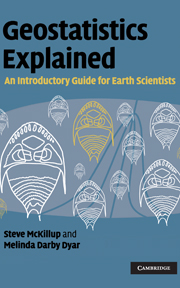Book contents
- Frontmatter
- Contents
- Preface
- 1 Introduction
- 2 “Doing science”: hypotheses, experiments and disproof
- 3 Collecting and displaying data
- 4 Introductory concepts of experimental design
- 5 Doing science responsibly and ethically
- 6 Probability helps you make a decision about your results
- 7 Working from samples: data, populations and statistics
- 8 Normal distributions: tests for comparing the means of one and two samples
- 9 Type 1 and Type 2 error, power and sample size
- 10 Single-factor analysis of variance
- 11 Multiple comparisons after ANOVA
- 12 Two-factor analysis of variance
- 13 Important assumptions of analysis of variance, transformations and a test for equality of variances
- 14 Two-factor analysis of variance without replication, and nested analysis of variance
- 15 Relationships between variables: linear correlation and linear regression
- 16 Linear regression
- 17 Non-parametric statistics
- 18 Non-parametric tests for nominal scale data
- 19 Non-parametric tests for ratio, interval or ordinal scale data
- 20 Introductory concepts of multivariate analysis
- 21 Introductory concepts of sequence analysis
- 22 Introductory concepts of spatial analysis
- 23 Choosing a test
- Appendices
- References
- Index
10 - Single-factor analysis of variance
Published online by Cambridge University Press: 05 June 2012
- Frontmatter
- Contents
- Preface
- 1 Introduction
- 2 “Doing science”: hypotheses, experiments and disproof
- 3 Collecting and displaying data
- 4 Introductory concepts of experimental design
- 5 Doing science responsibly and ethically
- 6 Probability helps you make a decision about your results
- 7 Working from samples: data, populations and statistics
- 8 Normal distributions: tests for comparing the means of one and two samples
- 9 Type 1 and Type 2 error, power and sample size
- 10 Single-factor analysis of variance
- 11 Multiple comparisons after ANOVA
- 12 Two-factor analysis of variance
- 13 Important assumptions of analysis of variance, transformations and a test for equality of variances
- 14 Two-factor analysis of variance without replication, and nested analysis of variance
- 15 Relationships between variables: linear correlation and linear regression
- 16 Linear regression
- 17 Non-parametric statistics
- 18 Non-parametric tests for nominal scale data
- 19 Non-parametric tests for ratio, interval or ordinal scale data
- 20 Introductory concepts of multivariate analysis
- 21 Introductory concepts of sequence analysis
- 22 Introductory concepts of spatial analysis
- 23 Choosing a test
- Appendices
- References
- Index
Summary
Introduction
So far, this book has only covered tests for one and two samples. Often, however, you are likely to have univariate data from three or more samples, from different localities (or experimental groups), and wish to test the hypothesis that “The means of the populations from which these samples have come from are not significantly different to each other,” or “μ1 = μ2 = μ3 = μ4 = μ4 etc…”
For example, you might have data for the percentage of tourmaline in granitic rocks from five different outcrops, and wish to test the hypothesis that these have come from populations with the same mean percentage of tourmaline, or perhaps even the same pluton.
Here you could test this hypothesis by doing a lot of two-sample t tests that compare all of the possible pairs of means (e.g. mean 1 compared to mean 2, mean 1 compared to mean 3, mean 2 compared to mean 3 etc.). The problem with this approach is that every time you do a two-sample test and the null hypothesis applies you run a 5% risk of a Type 1 error. So as you do more and more tests on the same set of data, the risk of a Type 1 error rises rapidly.
Put simply, if you do two or more two-sample tests on the same data set it is like having more than one ticket in a lottery where the chances of winning are 5% – the more tickets you have, the more likely you are to win.
- Type
- Chapter
- Information
- Geostatistics ExplainedAn Introductory Guide for Earth Scientists, pp. 115 - 130Publisher: Cambridge University PressPrint publication year: 2010



